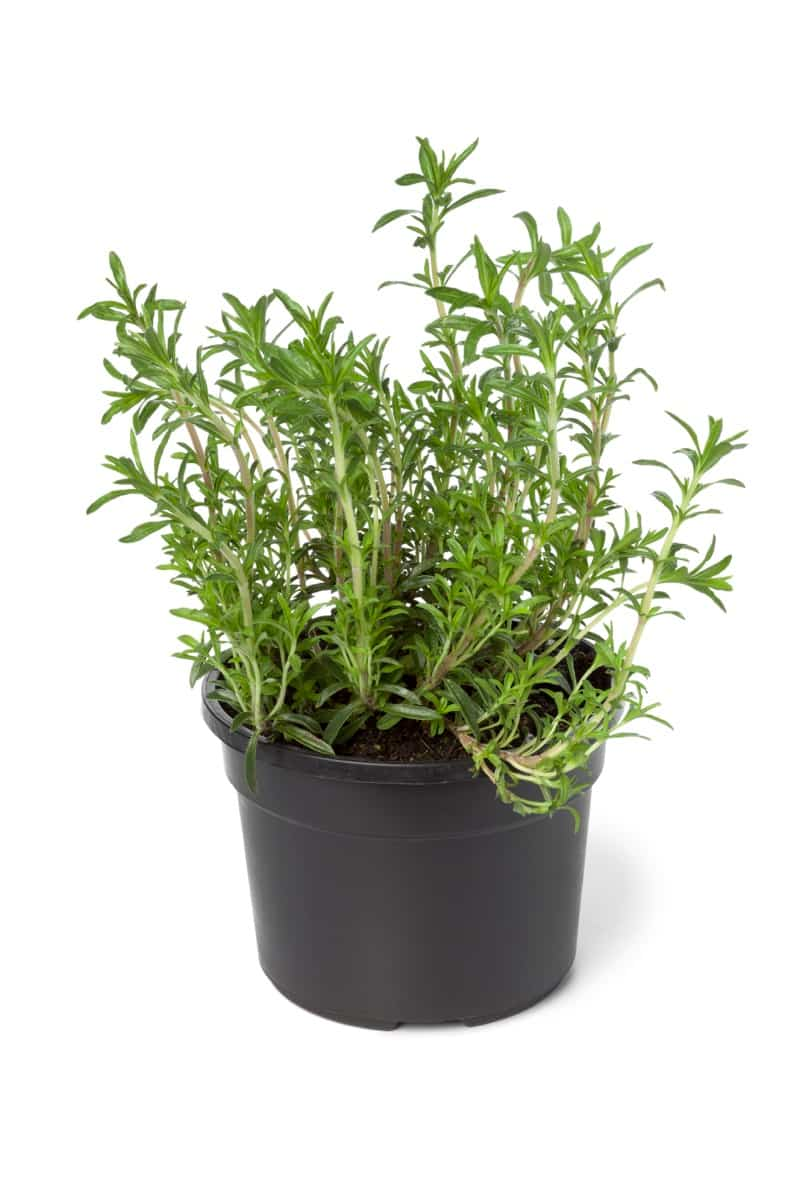Savory is a delightful herb from the mint family, Lamiaceae; it brings flavor to any culinary creation. This aromatic plant originated in southern Europe, the Mediterranean, and southwest Asia – regions known for their rich culinary traditions. Why grow organic Savory? It would help if you considered adding this versatile herb to your garden for many reasons. Growing organic Savory gives you complete control over what goes into your plants.

How to Grow Organic Savory
Creating Nutrient-rich Soil for Organic Savory Herbs
Creating nutrient-rich soil is essential for growing healthy and thriving organic Savory herbs. Ensure your soil is well-drained to provide the ideal growing conditions for Savory plants. This will prevent waterlogging and help maintain a healthy root system. Winter Savory prefers sandy soil that drains easily. Savory prefers a slightly acidic to neutral pH range of 6.7 to 7.3. Testing your soil’s pH can be done using a simple kit available at most garden centers.
Step-by-step Guide to Cultivating Organic Savory Plants
Choose the Right Location – When cultivating organic Savory plants, selecting a location that receives full sun is important. Savory thrives in warm and sunny conditions, so find a spot in your garden that gets at least six hours of direct sunlight each day.
Prepare the Soil – Before planting Savory seeds or seedlings, prepare the soil properly. Savory prefers well-drained soil, so amend heavy clay soils with organic matter like compost or aged manure. This will provide nutrients for healthy growth.
Planting Seeds or Seedlings – If you’re starting Savory from seeds, sow them directly into the prepared soil after the last frost date in your area. Cover them lightly with soil and water gently. If using Savory seedlings, dig a hole slightly larger than their root ball and place them carefully into the ground.
Watering – Water regularly but avoid overwatering as excessive moisture can lead to root rot. Check the soil’s moisture level by inserting a finger an inch deep – if it feels dry, it’s time to water. Aim for consistent moisture without allowing the soil to become soggy.
Mulching for Weed Control – Apply a layer of organic mulch around your Savory plants to suppress weed growth. This will also help maintain more even temperatures during hot summer months.
Regular Care – Look for any pests or diseases that may affect your Savory plants. Prune away dead or diseased leaves regularly to promote air circulation and prevent fungal infections. Additionally, remove weeds that may compete with your herbs for nutrients.
In case you missed it: How to Grow Organic Yarrow: A Guide to Planting, Care, and Harvest

Information about Growing Organic Savory
| Common Name | Savory |
| Scientific Name | Satureja hortensis |
| Light Preference | Sun |
| Soil Requirements | Grows best in medium-rich, sandy soil |
| Hardiness Zones | Annual |
| Harvest | Cut for fresh use once the Savory plants have become established |
Proper Watering Techniques for Organic Savory Cultivation
Proper watering is crucial for the successful cultivation of organic Savory plants. Aim for watering once or twice a week during dry spells or when significant rainfall hasn’t occurred. Ensure the soil has proper drainage to control waterlogged roots and potential diseases. Watering early in the morning or late in the evening is best as it reduces evaporation and allows foliage to dry before nightfall. This helps prevent diseases from taking hold.
Natural Fertilizers for Promoting Organic Savory Growth
- Compost – It serves as a rich source of organic matter and nutrients. You can make your compost by recycling kitchen scraps, yard waste, and other biodegradable materials. Apply compost around the base of your Savory plants to improve soil fertility and moisture retention.
- Seaweed extract – Packed with trace minerals, this natural fertilizer stimulates root development and enhances plant resilience. Dilute it in water based on package instructions and use it as a foliar spray or root drench for optimal results.
- Worm castings – Worms break down organic matter into nutrient-rich castings that nourish plants without any risk of burning them. Sprinkle a thin layer around your Savory plants’ base or mix it into the soil during planting.
- Mulching – Applying an organic mulch such as straw or wood chips helps retain moisture, suppress weeds, regulate soil temperature, and slowly release nutrients.
Organic Pest Control Methods for Savory Plants
One natural pest control method in Savory is companion planting. You can repel pests naturally by strategically placing certain plants near your Savory herbs. For example, marigolds deter aphids and nematodes, while chives help ward off carrot flies. Another option is homemade insecticidal sprays from ingredients like garlic or hot pepper. These can be applied to the plant leaves to deter insects without harming beneficial bugs.
In case you missed it: Herbal Remedies for Houseplant Pests and Diseases: Prevention, Treatment, and Solutions

Additionally, practicing good garden hygiene is crucial in preventing pest infestations. Regularly removing weeds and debris around your Savory herbs reduces hiding places for pests and helps maintain overall plant health. Introducing beneficial insects can help control pests like aphids or caterpillars. These helpful bugs feed on harmful insects, keeping their populations in check naturally.
Pruning and Maintenance Tips for Organic Savory Plants
Regular pruning helps to promote bushier growth, prevent disease, and ensure an abundant harvest of flavorful leaves. How do you prune a Savory plant? Start by removing any damaged stems from the plant. Use clean garden pruners to make clean cuts at about 45-degree angle just above a leaf node. This will increase new growth and prevent the spread of infection.
To maintain the shape of your Savory plants, trim back any overly long branches or straggly growth. Focus on maintaining a compact, well-rounded form that allows sunlight to reach all plant parts. Additionally, be mindful of pests such as aphids or spider mites that may infest your Savory plants. Check regularly for signs of damage or infestation, and take some measures, such as using organic insecticidal soap or practicing companion planting with pest-repellent herbs like basil or marigold.
Seasonal Care Instructions for Organic Savory Plants
Spring: In the spring, it’s important to prepare your Savory plants for a successful growing season. Start by loosening the soil that may have sprouted. This will ensure that your Savory herbs have plenty of room to grow and receive adequate nutrients. During this time, it is also crucial to monitor moisture levels in the soil.
Summer: As summer arrives, protect your Savory plants from extreme heat and excessive sunlight. If you observe any issues, promptly address them with organic pest control methods in Savory, such as spraying with neem oil or introducing beneficial insects like ladybugs.
Fall: Trim back any dead or damaged foliage on your Savory plants before temperatures drop too low. This will help promote healthy growth when spring returns. Additionally, consider covering your Savory herb garden with mulch or straw to protect against frost and cold snaps during late fall and winter.
Winter: During winter, be mindful of excess moisture accumulating around your dormant Savory plants. Ensure proper drainage by avoiding over-watering and maintaining airflow within your garden beds. While less active during this season, monitor for signs of pests that may affect your precious herbs, even in colder temperatures.
Harvesting and Preserving Organic Savory for Culinary Use
When harvesting Savory, using a garden pruner or scissors is ideal. Snip the leaves and stems as needed, not damaging the plant. For dried leaves, cut 6- to 8-inch stems just before flowering. This will ensure optimal flavor and potency in your dried herbs. If you prefer fresh Savory for immediate use, wait until the plants have become established before cutting them.
Take what you need while leaving enough foliage for the plant to grow. Once you’ve harvested your precious bounty of Savory herbs, it’s time to think about preservation methods. Drying is one of the most common ways to preserve herbs like Savory. To do this effectively, hang the plants in a warm, dark location with good ventilation. Allow them to dry before storing Savory in an airtight container.
In case you missed it: How to Grow Organic Sage: A Step-by-Step Guide to Planting, Care, and Harvest

Conclusion
Providing rich and well-drained organic soil with optimal pH levels creates an ideal environment for your Savory herbs to flourish and contribute their delightful aroma. By choosing to grow organically, you reduce pollution and protect wildlife by creating a habitat that supports beneficial insects and microorganisms. Avoiding harmful pesticides and synthetic fertilizers ensures that the herbs you harvest are free from potentially harmful chemicals.
- Ultimate Guide to Ossabaw Island Hog: Breeding, Raising, Diet, and Care
- Ultimate Guide to Juliana Pig: Raising Facts, Size, Diet, Care, and Lifespan
- Raising Lleyn Sheep: Disadvantages, Price, Uses, Characteristics, and Care
- Ultimate Guide to Meishan Pig: Breed Facts, Breeding, Raising, and Care
- Ultimate Guide to Teacup Pigs: Raising, Diet, Lifespan, Cost, and Care
- Guide to Raising Poll Dorset Sheep: Facts, Profile, Characteristics, Uses, and Care
- Ultimate Guide to Bighorn Sheep: Characteristics, Diet, Lifespan, Breeding, and Lifecycle
- Ultimate Guide to Raising Katahdin Sheep: Farming Facts, Breed Profile, Uses, and Care
- Ultimate Guide to Raising Oreo Cows: Belted Galloways Farming Facts, Profile, Uses, and Care